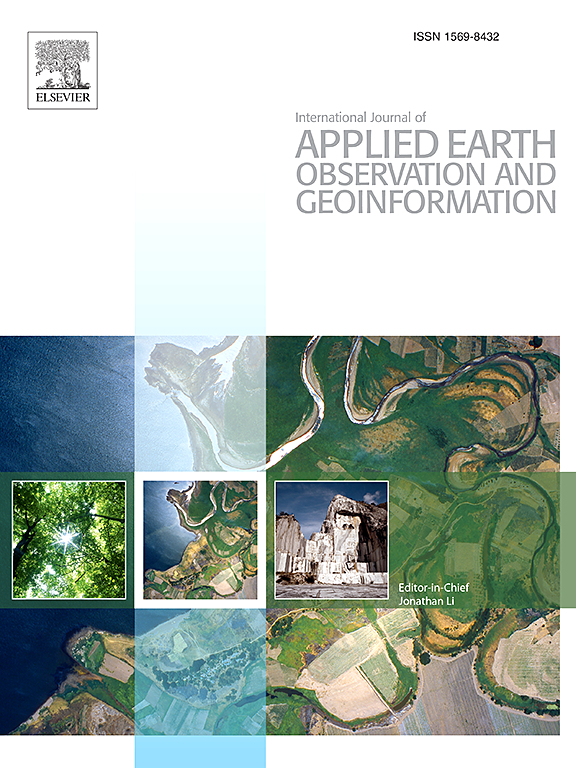Spatially predicting ecosystem service patterns in boreal drained peatlands forests using multisource satellite data
IF 7.6
Q1 REMOTE SENSING
International journal of applied earth observation and geoinformation : ITC journal
Pub Date : 2025-04-19
DOI:10.1016/j.jag.2025.104545
引用次数: 0
Abstract
Boreal drained-peatland forests provide diverse, interlinked ecosystem services (ESs), critical for informed decision-making in forest management. We mapped five ESs: bilberry yield, visual amenity, biodiversity conservation, carbon storage, and timber production using Landsat 8–9, Sentinel-2, and PlanetScope data. By combining these five ESs variables, we calculated a summed-ESs variable to capture overall ESs in drained peatland forests. Our objectives included assessing the influence of sensor resolution, auxiliary data, and the feasibility of scaling ESs predictions across varying canopy covers (closed, partial, and open). Using spectral bands and indices, we applied random forest regression, achieving explained variances (R2) of 13–75 % for single ESs and 58–67 % for summed ESs. Sensor performance varied, with Landsat (R2 22–69 %), Sentinel-2 (R2 25–75 %), and PlanetScope (R2 13–65 %). Incorporating auxiliary variables from seven-year-old LiDAR data improved model R2 value by 1–24 %. We successfully scaled ESs predictions to map spatial distributions across the study area, with high ESs value in closed-canopy areas. These findings demonstrate satellite imagery’s effectiveness for spatial ESs prediction, supporting sustainable drained-peatland forest management.
利用多源卫星数据预测北方干流泥炭地森林生态系统服务模式
北方疏水泥炭地森林提供多样化、相互关联的生态系统服务,对森林管理中的知情决策至关重要。我们利用Landsat 8-9、Sentinel-2和PlanetScope数据绘制了5个ESs:越莓产量、视觉舒适度、生物多样性保护、碳储量和木材产量。通过结合这五个ESs变量,我们计算了一个总和ESs变量,以捕获排水泥炭地森林的总体ESs。我们的目标包括评估传感器分辨率、辅助数据的影响,以及在不同冠层覆盖度(封闭、部分和开放)上缩放ESs预测的可行性。利用光谱带和指数,我们应用随机森林回归,单个ESs的解释方差(R2)为13 - 75%,总和ESs的解释方差(R2)为58 - 67%。传感器性能各不相同,Landsat (R2 22 - 69%), Sentinel-2 (R2 25 - 75%)和PlanetScope (R2 13 - 65%)。结合7年前LiDAR数据的辅助变量,模型R2值提高了1 - 24%。我们成功地缩放了ESs预测,绘制了整个研究区域的空间分布,在封闭的冠层区域,ESs值较高。这些发现证明了卫星图像在空间ESs预测方面的有效性,支持了可持续的泥炭地森林管理。
本文章由计算机程序翻译,如有差异,请以英文原文为准。
求助全文
约1分钟内获得全文
求助全文
来源期刊

International journal of applied earth observation and geoinformation : ITC journal
Global and Planetary Change, Management, Monitoring, Policy and Law, Earth-Surface Processes, Computers in Earth Sciences
CiteScore
12.00
自引率
0.00%
发文量
0
审稿时长
77 days
期刊介绍:
The International Journal of Applied Earth Observation and Geoinformation publishes original papers that utilize earth observation data for natural resource and environmental inventory and management. These data primarily originate from remote sensing platforms, including satellites and aircraft, supplemented by surface and subsurface measurements. Addressing natural resources such as forests, agricultural land, soils, and water, as well as environmental concerns like biodiversity, land degradation, and hazards, the journal explores conceptual and data-driven approaches. It covers geoinformation themes like capturing, databasing, visualization, interpretation, data quality, and spatial uncertainty.
 求助内容:
求助内容: 应助结果提醒方式:
应助结果提醒方式:


